Finite Element Modeling for Debonding of FRP-to-Concrete Interfaces Subjected to Mixed-Mode Loading
Abstract
:1. Introduction
2. Peeling Test and Linear Elastic Fracture Mechanics (LEFM) Analysis
3. Finite Element Modeling of the Peeling Test
4. Parametric Analyses
4.1. Influence of the Unbonded Length of FRP Lamina
4.2. Influence of the Peel Angle
4.3. Influence of the Shape of Cohesive Law
4.4. Influence of the Damage Initiation and Evolution Laws
5. Full-Range Debonding Process of an FRP-to-Concrete Interface Subject to Mixed-Mode Loading
6. Conclusions
- Regardless of the peel angle, the entire debonding process of FRP-to-concrete interfaces consists of two phases: the initiation phase and the steady-state peeling phase. With the increase of peel angle (e.g., >4 degree), the debonding process shifts rapidly from mode II-dominated to mode I-dominated. Below this angle, the mode I and mode II components have comparable amplitudes, so their coupling effect is very significant.
- The orthotropic plane stress element scheme seems to be most appropriate for the simulation of the FRP lamina during the mix-mode debonding of FRP-to-concrete interfaces and the mechanical properties can be determined based on the composite mechanics.
- In case of large peel angle (e.g., >4 degree), both the DIL and the DEL have an insignificant influence on the peeling process; while, when the peel angle is relatively small, both the DIL and DEL have a significant influence on the peeling force. The quadric DIL leads to higher peeling force than the maximum cohesive strength DIL. Besides, the power DEL leads to higher peeling force than the linear DEL.
- Analyses of the full-range mixed-mode debonding process helps to achieve a thorough understanding of phenomena observed in the peeling test of an FRP-to-concrete interface, in terms of the global load-displacement curves, and the local strain distributions along the FRP lamina length as well as the stress-strain evolution history at different load levels.
Acknowledgments
Author Contributions
Conflicts of Interest
References
- Teng, J.G.; Chen, J.F.; Smith, S.T.; Lam, L. FRP-Strengthened RC Structures; John Wiley & Sons: New York, NY, USA, 2002. [Google Scholar]
- Hollaway, L.C.; Teng, J.G. Strengthening and Rehabilitation of Civil Infrastructures Using Fibre-Reinforced Polymer (FRP) Composites; Woodhead Publishing Ltd.: Cambridge, UK, 2008. [Google Scholar]
- Seyhan, E.C.; Goksu, C.; Uzunhasanoglu, A.; Ilki, A. Behavior of substandard RC columns retrofitted with embedded aramid fiber reinforced polymer (AFRP) reinforcement. Polymers 2015, 7, 2535–2557. [Google Scholar] [CrossRef]
- Lee, S.K.; Lee, Y.B.; Seo, Y.S. A seismic strengthening technique for reinforced concrete columns using sprayed FRP. Polymers 2016, 8, 107–128. [Google Scholar] [CrossRef]
- Ueda, T.; Dai, J.G. Interface of fiber reinforced polymer laminates externally bonded to concrete substrate: From test methods to bond modeling. In Proceedings of the International Symposium on Bond Behaviour of FRP in Structures (BBFS 2005), Hong Kong, China, 7–9 December 2005; pp. 23–34. [Google Scholar]
- Wu, Z.S.; Yuan, H.; Asakura, T.; Yoshizawa, H.; Kobayashi, A.; Kojima, Y. Peeling behavior and spalling resistance of bonded bidirectional fiber reinforced polymer sheets. J. Compos. Constr. 2005, 9, 214–226. [Google Scholar] [CrossRef]
- Wu, Z.S.; Yuan, H.; Kojima, Y.; Ahmed, E. Experimental and analytical studies on peeling and spalling resistance of unidirectional FRP sheets bonded to concrete. Compos. Sci. Technol. 2005, 65, 1088–1097. [Google Scholar] [CrossRef]
- Dai, J.G.; Ueda, T.; Sato, Y. Bonding characteristics of fiber-reinforced polymer sheet-concrete interfaces under dowel load. J. Compos. Constr. 2007, 11, 138–148. [Google Scholar] [CrossRef]
- Dai, J.G.; Cao, Y.B. Debonding Behavior of Skew FRP-Bonded Concrete Joints. In Proceedings of the 5th International Conference on FRP Composites in Civil Engineering (CICE2010), Beijing, China, 27–29 September 2010. [Google Scholar]
- Taljsten, B. Defining anchor lengths of steel and CFRP plates bonded to concrete. Int. J. Adhes. Adhes. 1997, 17, 319–327. [Google Scholar] [CrossRef]
- Chen, J.F.; Teng, J.G. Anchorage strength models for FRP and steel plates bonded to concrete. J. Struct. Eng. 2001, 127, 784–791. [Google Scholar] [CrossRef]
- De Lorenzis, L.; Miller, B.; Nanni, A. Bond of fiber-reinforced polymer laminates to concrete. Aci. Mater. J. 2001, 98, 256–264. [Google Scholar]
- Yuan, H.; Wu, Z.; Yoshizawa, H. Theoretical solutions on interfacial stress transfer of externally bonded steel/composite plates. J. Struct. Mech. Earthq. Eng. 2001, 18, 27–39. [Google Scholar]
- Dai, J.G.; Ueda, T.; Sato, Y. Development of the nonlinear bond stress-slip model of fiber reinforced plastics sheet-concrete interfaces with a simple method. J. Compos. Constr. 2005, 9, 52–62. [Google Scholar] [CrossRef]
- Lu, X.Z.; Teng, J.G.; Ye, L.P.; Jiang, J.J. Bond-slip models for FRP sheets/plates bonded to concrete. Eng. Struct. 2005, 27, 920–937. [Google Scholar] [CrossRef]
- Yao, J.; Teng, J.G.; Chen, J.F. Experimental study on FRP-to-concrete bonded joints. Compos. Part B 2005, 36, 99–113. [Google Scholar] [CrossRef]
- Gao, W.Y.; Teng, J.G.; Dai, J.G. Effect of Temperature Variation on the Full-Range Behavior of FRP-to-concrete Bonded Joints. J. Compos. Constr. 2012, 16, 671–683. [Google Scholar] [CrossRef]
- Au, C.; Büyüköztürk, O. Debonding of FRP plated concrete: A tri-layer fracture treatment. Eng. Fract. Mech. 2006, 73, 348–365. [Google Scholar] [CrossRef]
- Biscaia, H.C.; Chastre, C.; Silva, M.A.G. Linear and nonlinear analysis of bond-slip models for interfaces between FRP composites and concrete. Compos. Part B 2013, 45, 1554–1568. [Google Scholar] [CrossRef]
- Biscaia, H.C.; Chastre, C.; Silva, M.A.G. Double shear tests to evaluate the bond strength between GFRP/concrete elements. Compos. Struct. 2012, 94, 681–694. [Google Scholar] [CrossRef]
- Zhou, Y.W.; Wu, Y.F.; Yun, Y. Analytical modeling of the bond-slip relationship at FRP-concrete interfaces for adhesively-bonded joints. Compos. Part B 2010, 41, 423–433. [Google Scholar] [CrossRef]
- Zhou, Y.W.; Fan, Z.H.; Du, J.; Sui, L.L.; Xing, F. Bond Behavior of FRP-to-Concrete Interface under Sulfate Attack: An Experimental Study and Modeling of Bond Degradation. Constr. Build. Mater. 2015, 85, 9–21. [Google Scholar] [CrossRef]
- Qiao, P.Z.; Xu, Y.W. Evaluation of fracture energy of composite-concrete bonded interfaces using three-point bend tests. J. Compos. Constr. 2004, 8, 352–359. [Google Scholar] [CrossRef]
- Coronado, C.A.; Lopez, M.M. Experimental characterization of concrete-epoxy interfaces. J. Mater. Civil. Eng. 2008, 20, 303–312. [Google Scholar] [CrossRef]
- Zheng, J.J.; Dai, J.G.; Fan, X.L. Fracture analysis of FRP-plated notched concrete beam subjected to three-point bending. J. Eng. Mech. 2016, 142, 04015096. [Google Scholar] [CrossRef]
- Dai, J.G.; Ueda, T.; Hasan, M.; Sato, Y. Mode I fracture behaviors of FRP-concrete interfaces. Proc. Jpn. Concr. Inst. 2003, 25, 1577–1582. [Google Scholar]
- Karbhari, V.M.; Engineer, M. Investigation of bond between concrete and composites: Use of a peel test. J. Reinf. Plast. Comp. 1996, 15, 208–227. [Google Scholar] [CrossRef]
- Wan, B.L.; Sutton, M.A.; Petrou, M.F.; Harries, K.; Ning, U. Investigation of bond between fiber reinforced polymer and concrete undergoing global mixed mode I/II loading. J. Eng. Mech. 2004, 130, 1467–1475. [Google Scholar] [CrossRef]
- Pan, J.; Leung, C.K.Y. Debonding along the FRP-concrete interface under combined pulling/peeling effects. Eng. Fract. Mech. 2007, 74, 132–150. [Google Scholar] [CrossRef]
- Alam, M.S.; Kanakubo, T.; Yasojima, A. shear-peeling bond strength between continuous fiber sheet and concrete. Aci. Struct. J. 2012, 109, 75–82. [Google Scholar]
- Mohammadi, T.; Wan, B.; Harries, K.A.; Sweriduk, M.E. Bond behavior of FRP–concrete in presence of intermediate crack debonding failure. J. Compos. Constr. 2017, 21, 04017018. [Google Scholar] [CrossRef]
- Ghorbani, M.; Mostofinejad, D.; Hosseini, A. Bond behavior of CFRP sheets attached to concrete through EBR and EBROG joints subject to Mixed-Mode I/Ii loading. J. Compos. Constr. 2017, 21, 04017034. [Google Scholar] [CrossRef]
- Wang, J. Cohesive zone model of FRP-concrete interface debonding under mixed-mode loading. Int. J. Solids. Struct. 2007, 44, 6551–6568. [Google Scholar] [CrossRef]
- Wang, J. Cohesive-bridging zone model of FRP-concrete interface debonding. Eng. Fract. Mech. 2007, 74, 2643–2658. [Google Scholar] [CrossRef]
- Wang, J.; Zhang, C. Nonlinear fracture mechanics of flexural-shear crack induced debonding of FRP strengthened concrete beams. Int. J. Solids. Struct. 2008, 45, 2916–2936. [Google Scholar] [CrossRef]
- Dai, J.G.; Wan, B.; Yokota, H.; Ueda, T. Fracture criterion for carbon fiber reinforced polymer sheet to concrete interface subjected to coupled pull-out and push-off actions. Adv. Struct. Eng. 2009, 12, 663–682. [Google Scholar] [CrossRef]
- De Lorenzis, L.; Zavarise, G. Modeling of mixed-mode debonding in the peel test applied to superficial reinforcements. Int. J. Solids. Struct. 2008, 45, 5419–5436. [Google Scholar] [CrossRef]
- De Lorenzis, L.; Zavarise, G. Cohesive zone modeling of interfacial stresses in plated beams. Int. J. Solids. Struct. 2009, 46, 4181–4191. [Google Scholar] [CrossRef]
- De Lorenzis, L.; Zavarise, G. Interfacial stress analysis and prediction of debonding for a thin plate bonded to a curved substrate. Int. J. Nonlin. Mech. 2009, 44, 358–370. [Google Scholar] [CrossRef]
- De Lorenzis, L.; Zavarise, G. Debonding analysis of thin plates from curved substrates. Eng. Fract. Mech. 2010, 77, 3310–3328. [Google Scholar] [CrossRef]
- Dimitri, R.; Trullo, M.; De Lorenzis, L.; Zavarise, G. Coupled cohesive zone models for mixed-mode fracture: A comparative study. Eng. Fract. Mech. 2015, 148, 145–179. [Google Scholar] [CrossRef]
- Michels, J.; Zile, E.; Czaderski, C.; Motavalli, M. Debonding failure mechanisms in prestressed CFRP/epoxy/concrete connections. Eng. Fract. Mech. 2014, 132, 16–37. [Google Scholar] [CrossRef]
- Kishi, N.; Zhang, G.F.; Mikami, H. Numerical cracking and debonding analysis of RC beams reinforced with FRP sheet. J. Compos. Constr. 2005, 9, 507–514. [Google Scholar] [CrossRef]
- Niu, H.; Karbhari, V.M.; Wu, Z. Diagonal macro-crack induced debonding mechanisms in FRP rehabilitated concrete. Compos. Part B 2006, 37, 627–641. [Google Scholar] [CrossRef]
- Lee, J.H.; Chacko, R.M.; Lopez, M.M. Use of mixed-mode fracture interfaces for the modeling of large-scale FRP-strengthened beams. J. Compos. Constr. 2010, 14, 845–855. [Google Scholar] [CrossRef]
- Yin, J.; Wu, Z.S.; Andou, T.; Kato, K. Modeling of mixed-mode debonding along FRP-concrete bond interface. In Proceedings of the World Conference on Computational Mechanics, Beijing, China, 5–10 September 2004. [Google Scholar]
- Alfano, G.; Crisfield, M.A. Finite element interface models for the delamination analysis of laminated composites. Mechanical and computational issues. Int. J. Numer. Meth. Eng. 2001, 50, 1701–1736. [Google Scholar] [CrossRef]
- Camanho, P.P.; Davila, C.G. Mixed-Mode Decohesion Elements for the Simulation of Delamination in Composite Materials; NASA TM-2002-21173; Hampton, VA, USA.
- Kendall, K. Adhesion and surface energy of elastic solids. J. Phys. D Appl. Phys. 1971, 4, 1186–1195. [Google Scholar] [CrossRef]
- Kendall, K. Thin-film peeling-elastic term. J. Phys. D Appl. Phys. 1971, 8, 1449–1452. [Google Scholar] [CrossRef]
- Kim, K.; Aravas, N. Elastoplastic analysis of the peel test. Int. J. Solids. Struct. 1988, 24, 417–435. [Google Scholar] [CrossRef]
- Hutchinson, J.W.; Suo, Z. Mixed-mode cracking in layered materials. Adv. Appl. Mech. 1992, 29, 63–191. [Google Scholar]
- Kafkalidis, M.S.; Thouless, M.D.; Yang, Q.D.; Ward, S.M. Deformation and fracture of adhesive layers constrained by plastically-deforming adherends. J. Adhes. Sci. Technol. 2000, 14, 1593–1607. [Google Scholar] [CrossRef]
- Thouless, M.D.; Jensen, H.M. Elastic fracture-mechanics of the peel-test geometry. J. Adhesion 1992, 38, 185–197. [Google Scholar] [CrossRef]
- Suo, Z.G.; Hutchinson, J.W. Interface crack between two elastic layers. Int. J. Fracture 1990, 43, 1–18. [Google Scholar] [CrossRef]
- ABAQUS. ABAQUS Standard User’s Manual, Volumes I-III, Version 6.8; ABAQUS: Providence, RI, USA, 2008. [Google Scholar]
- Yu, T.; Teng, J.G.; Chen, J.F. Mechanical properties of FRP composites. In ICE Manual of Construction Materials; Thomas Telford: London, UK, 2009; Chapter 54; pp. 641–647. [Google Scholar]
- CNR-DT 200/2004: Guide for the Design and Construction of Externally Bonded FRP Systems for Strengthening Existing Structures-Materials, RC and PC Structures, Masonry Structures; CNR: Rome, Italy, 2004.


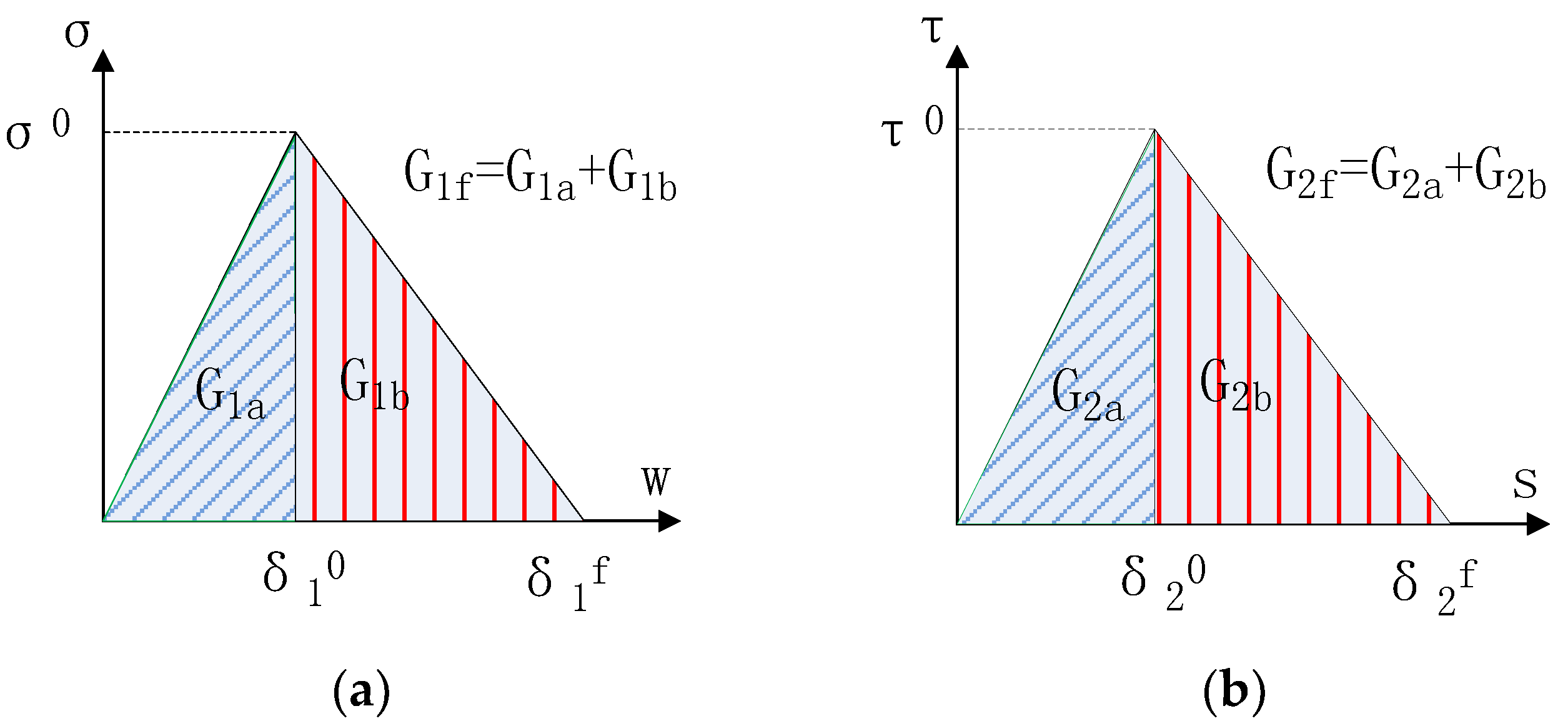
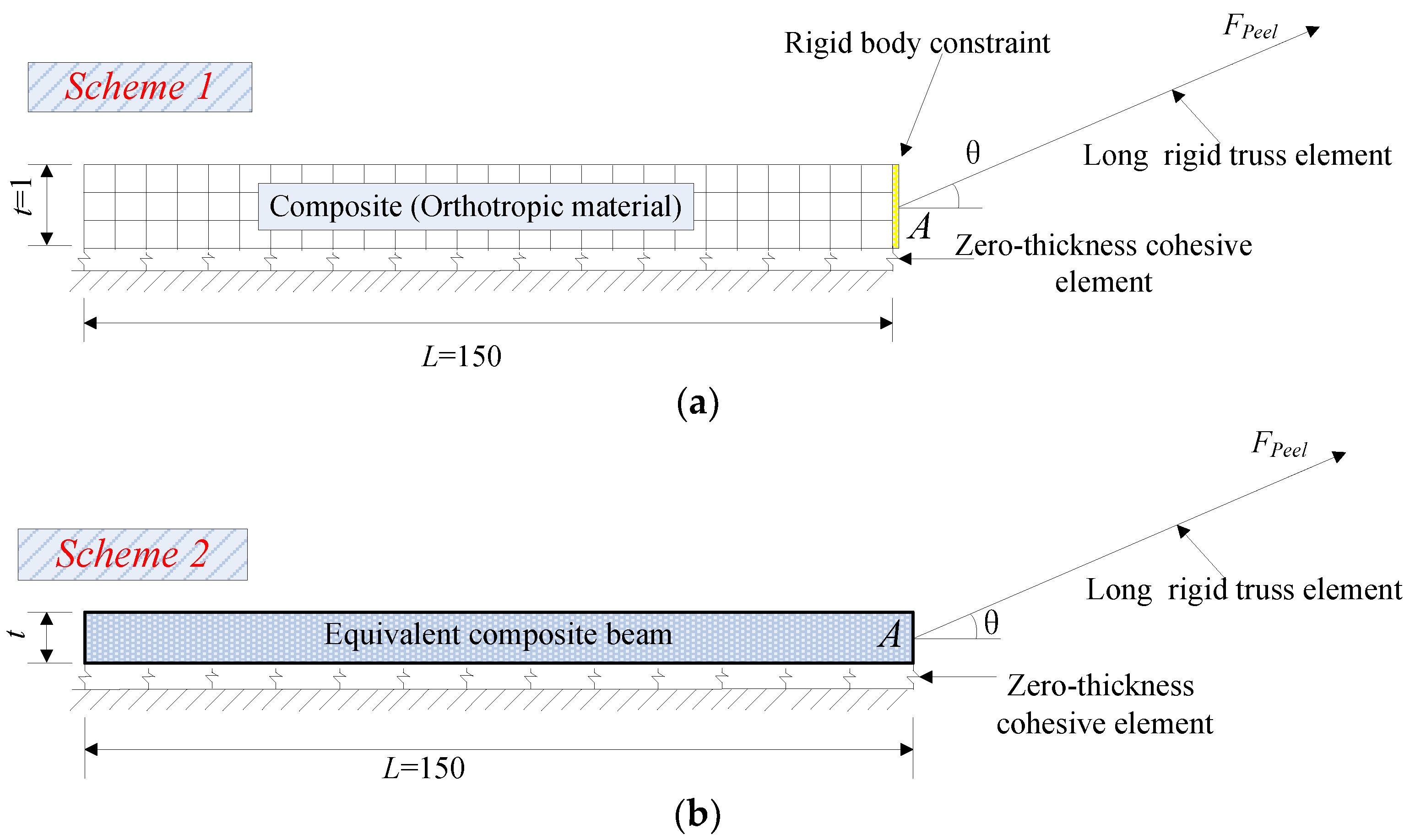
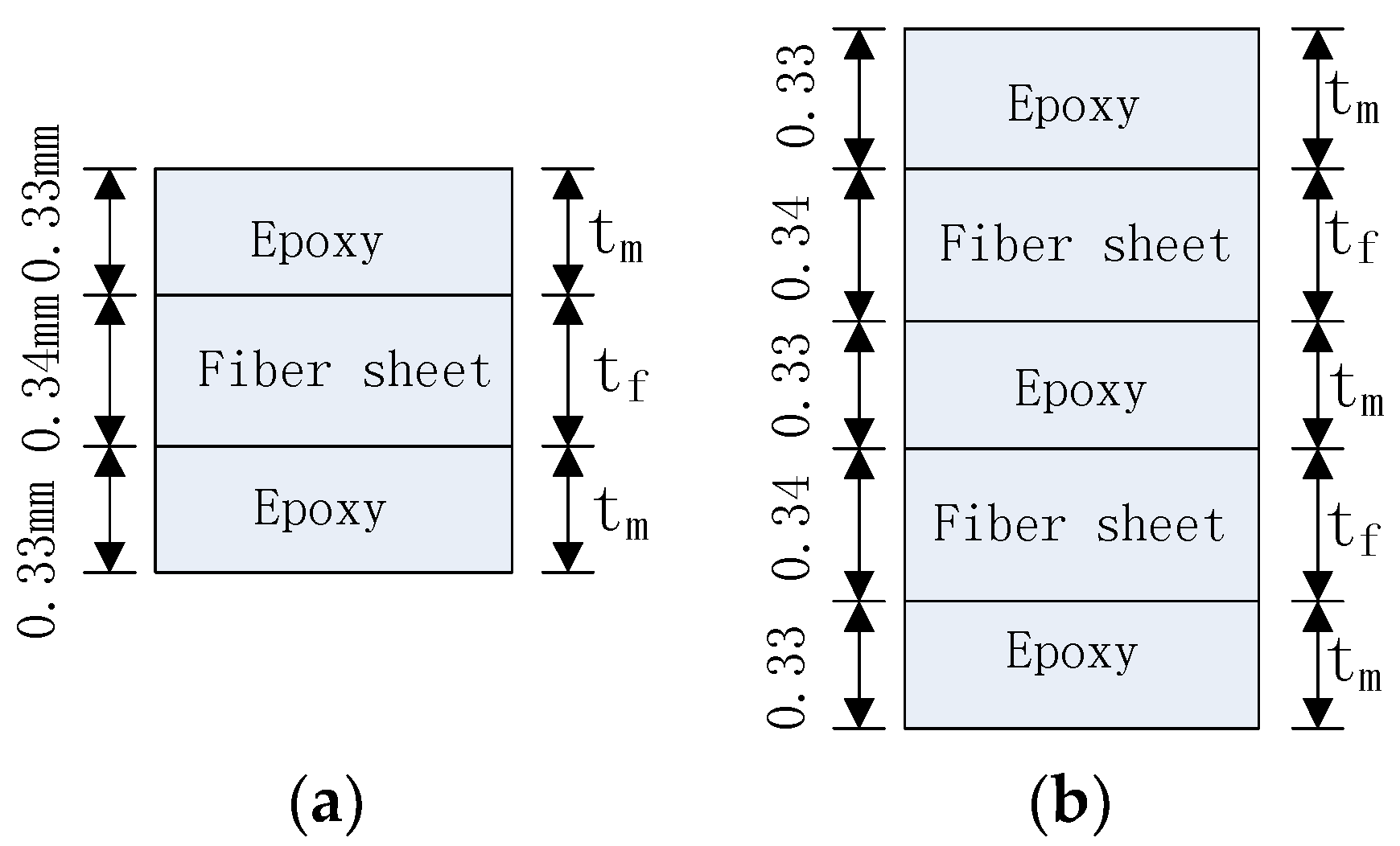
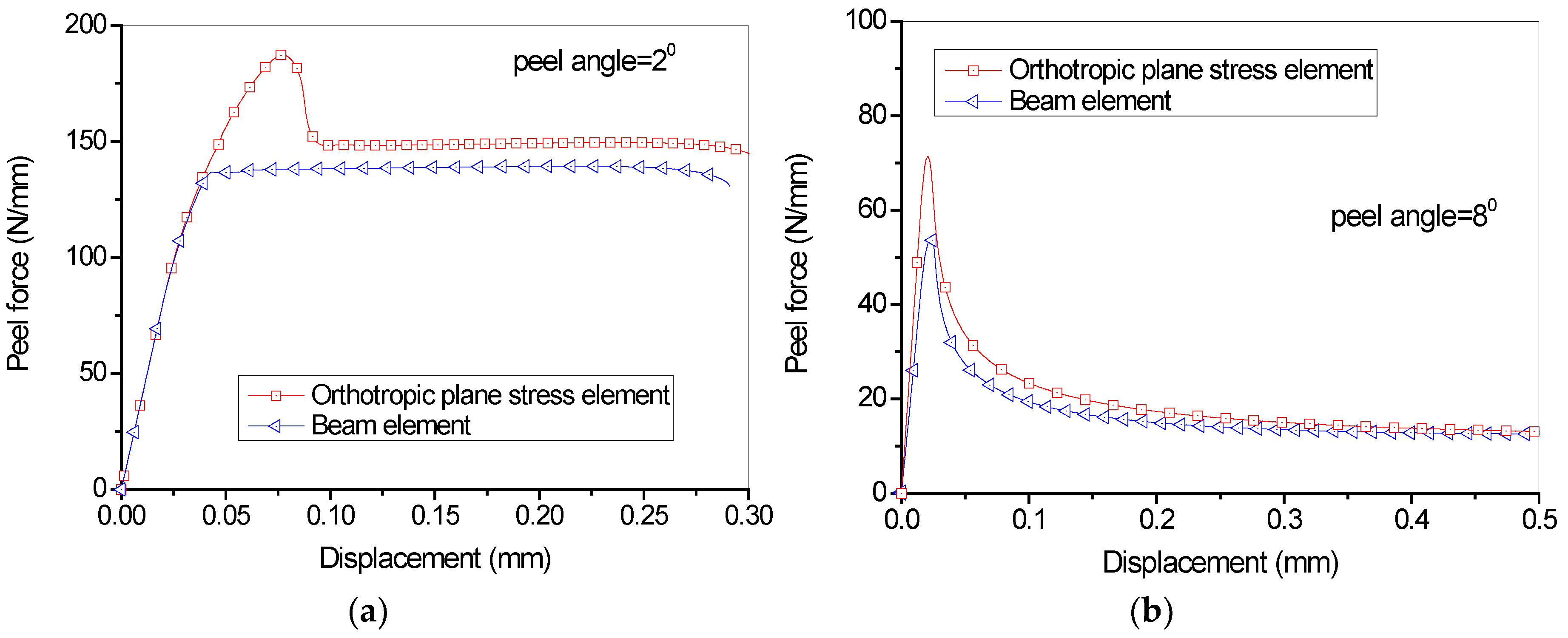
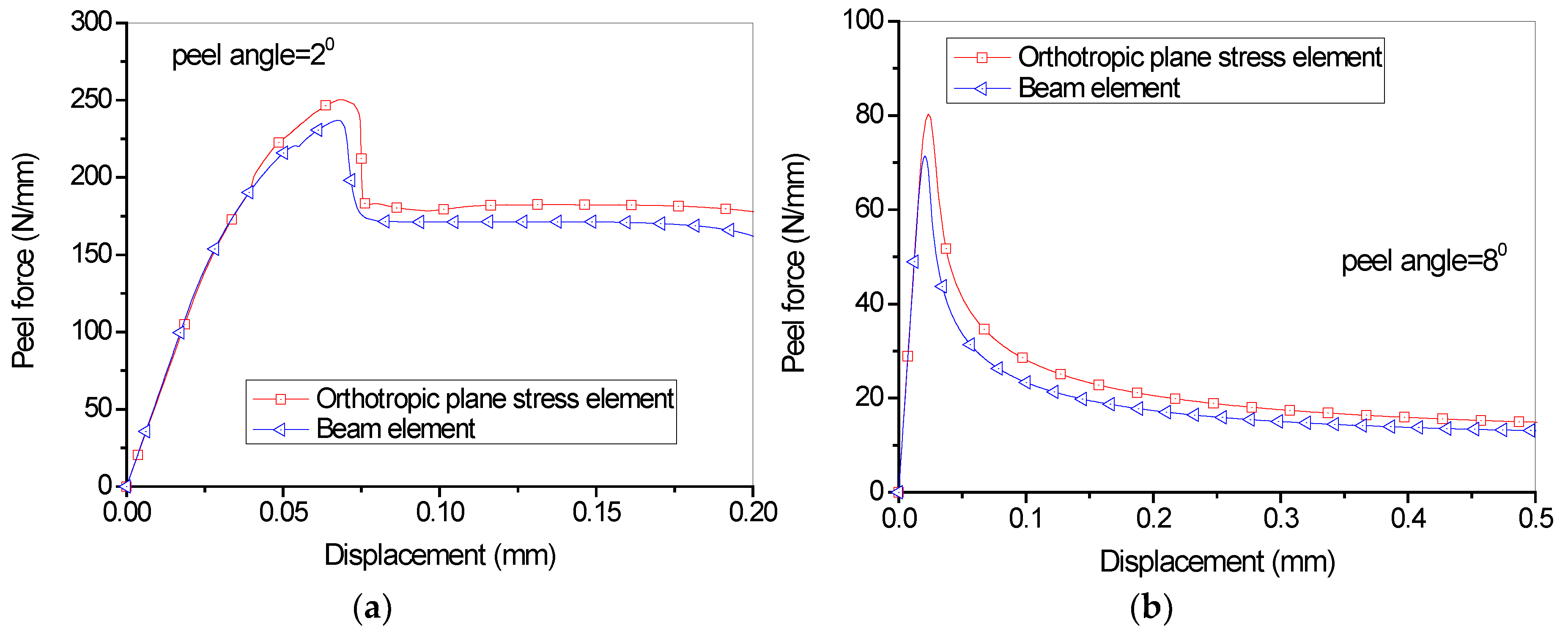
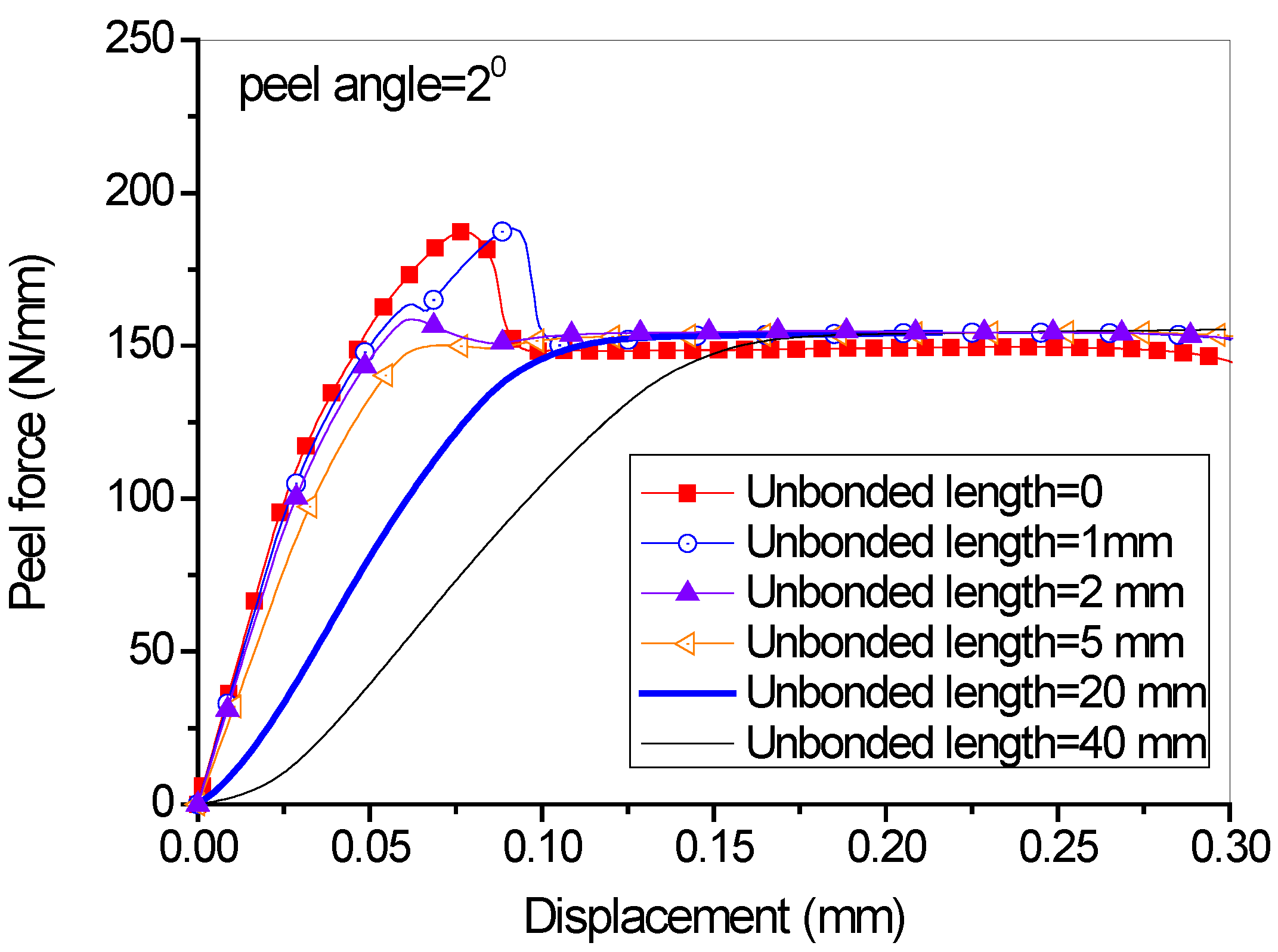
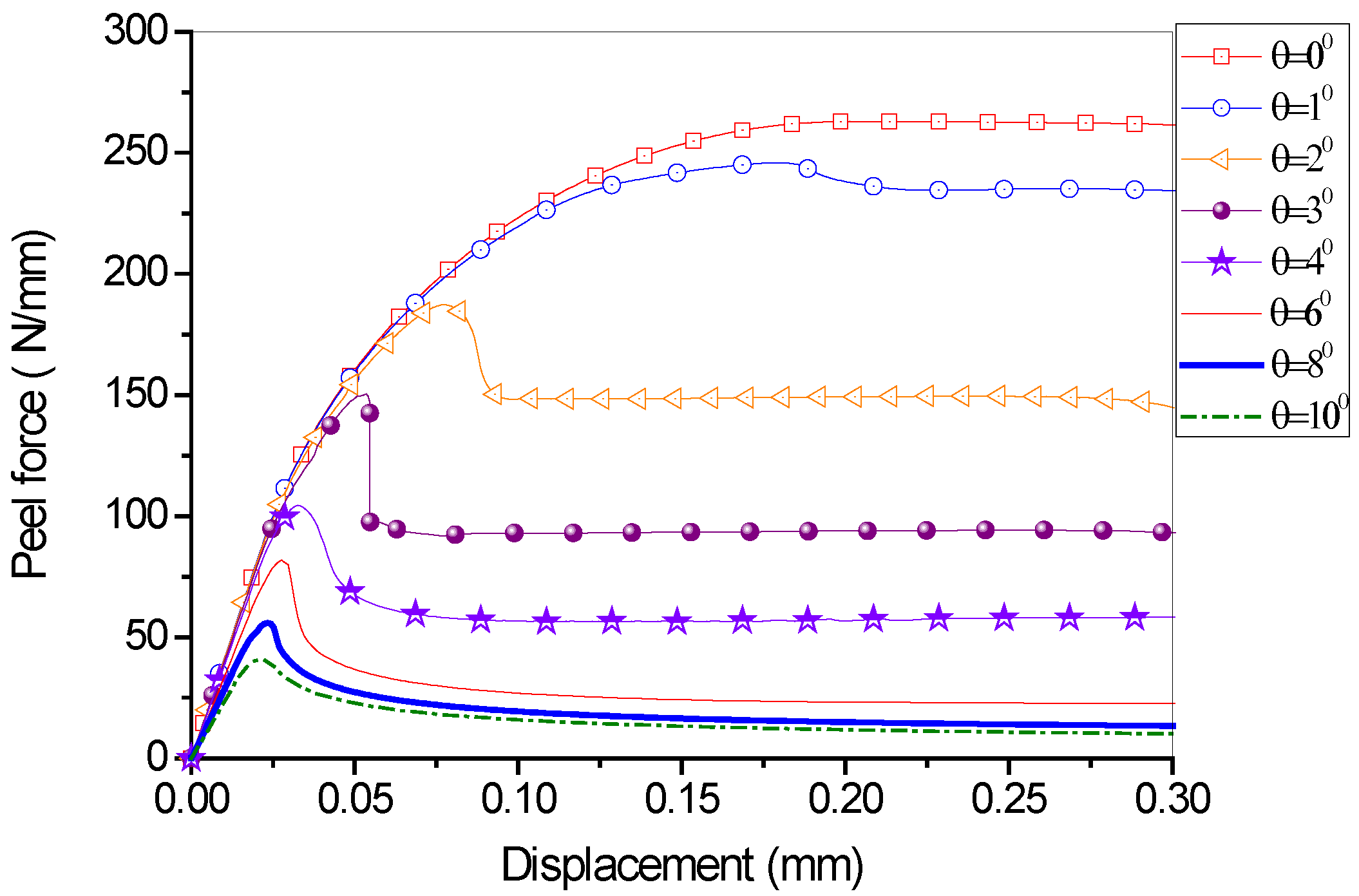

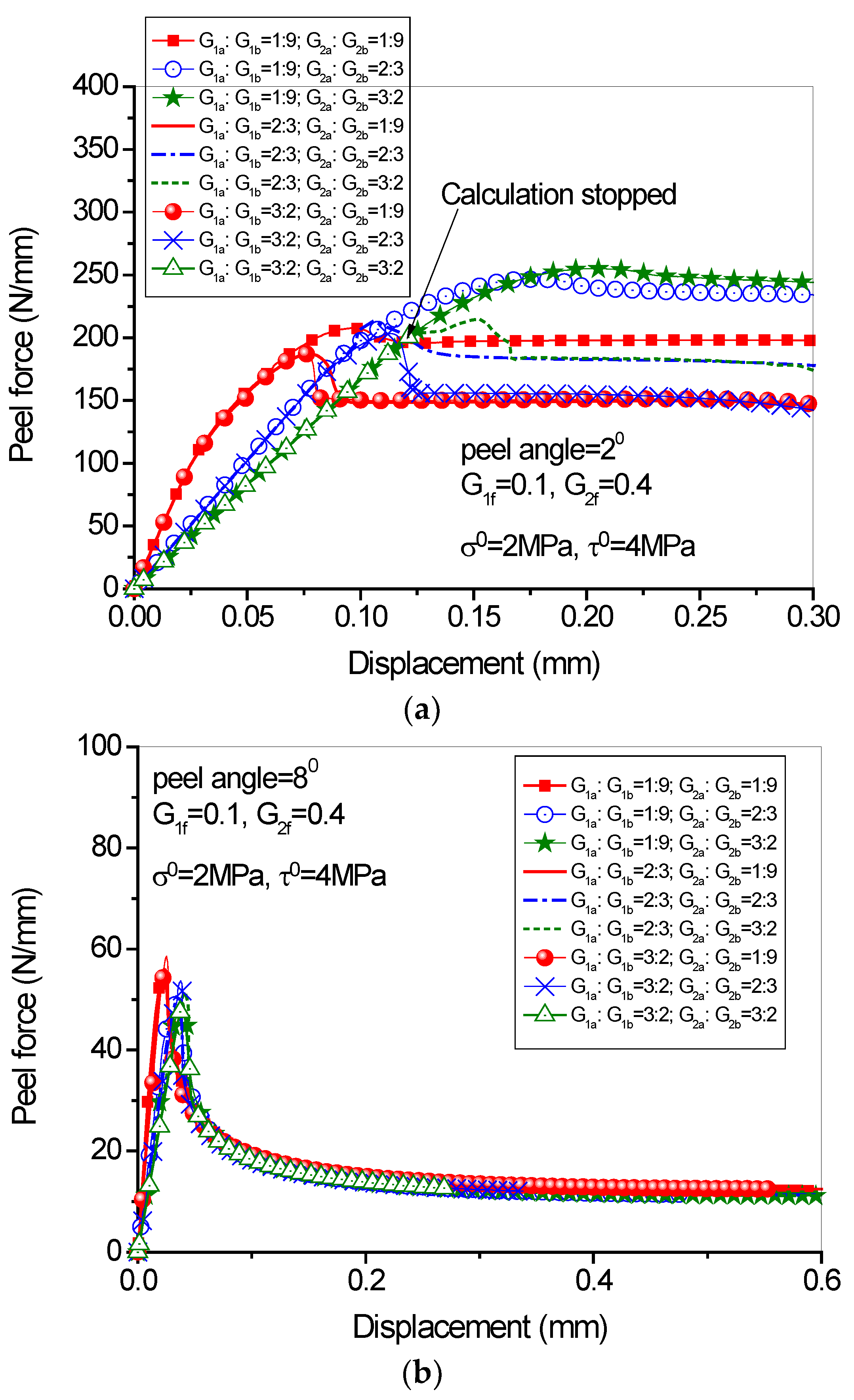
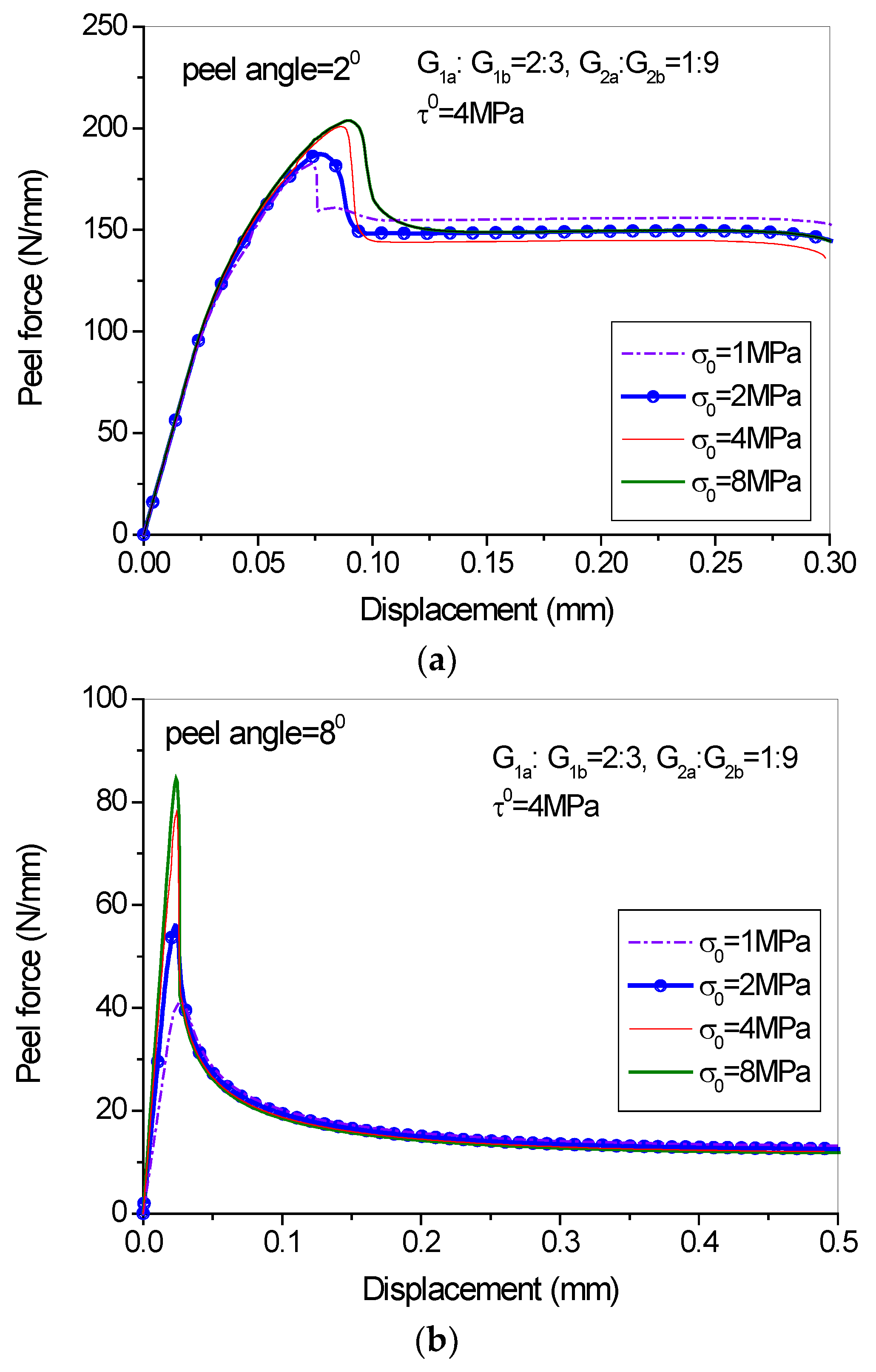

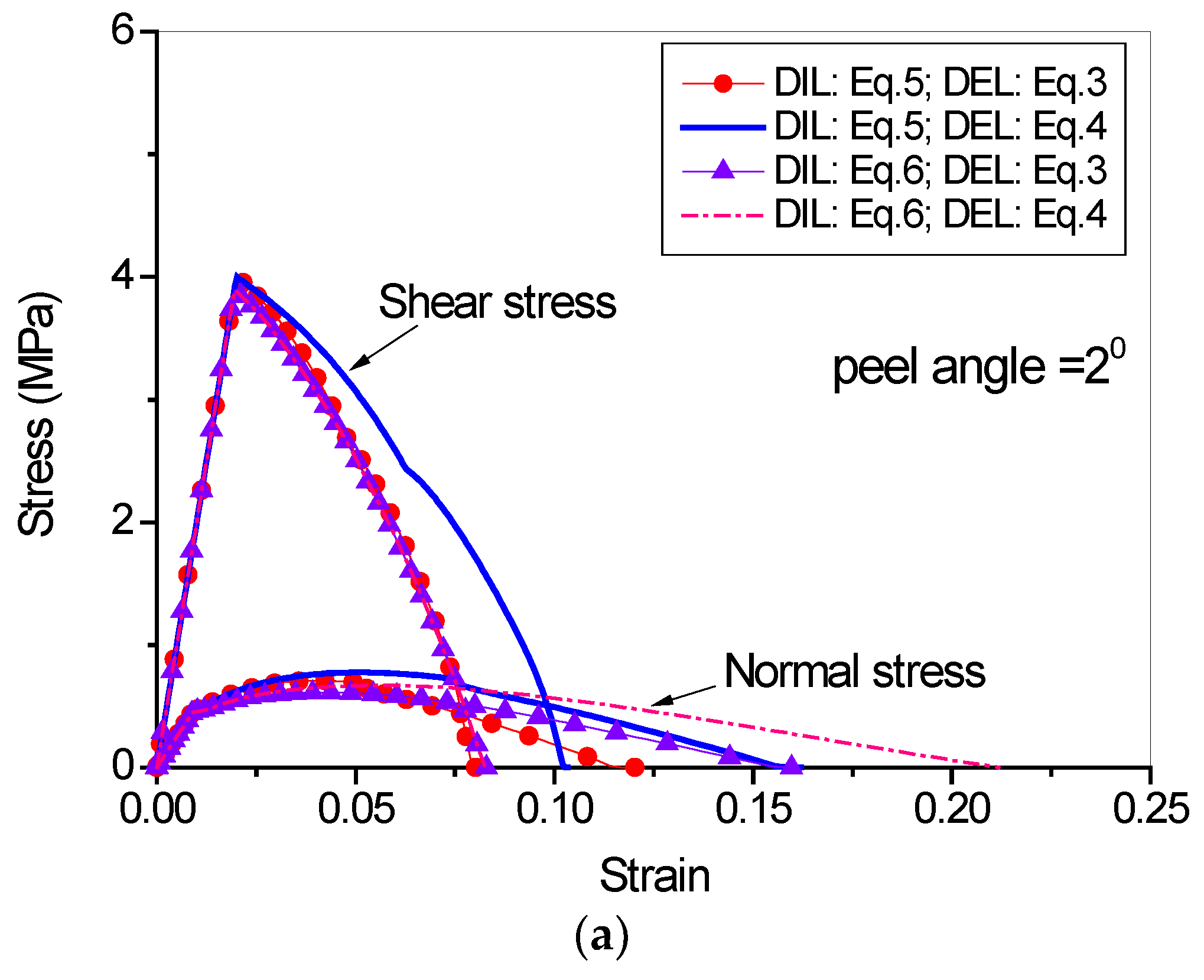
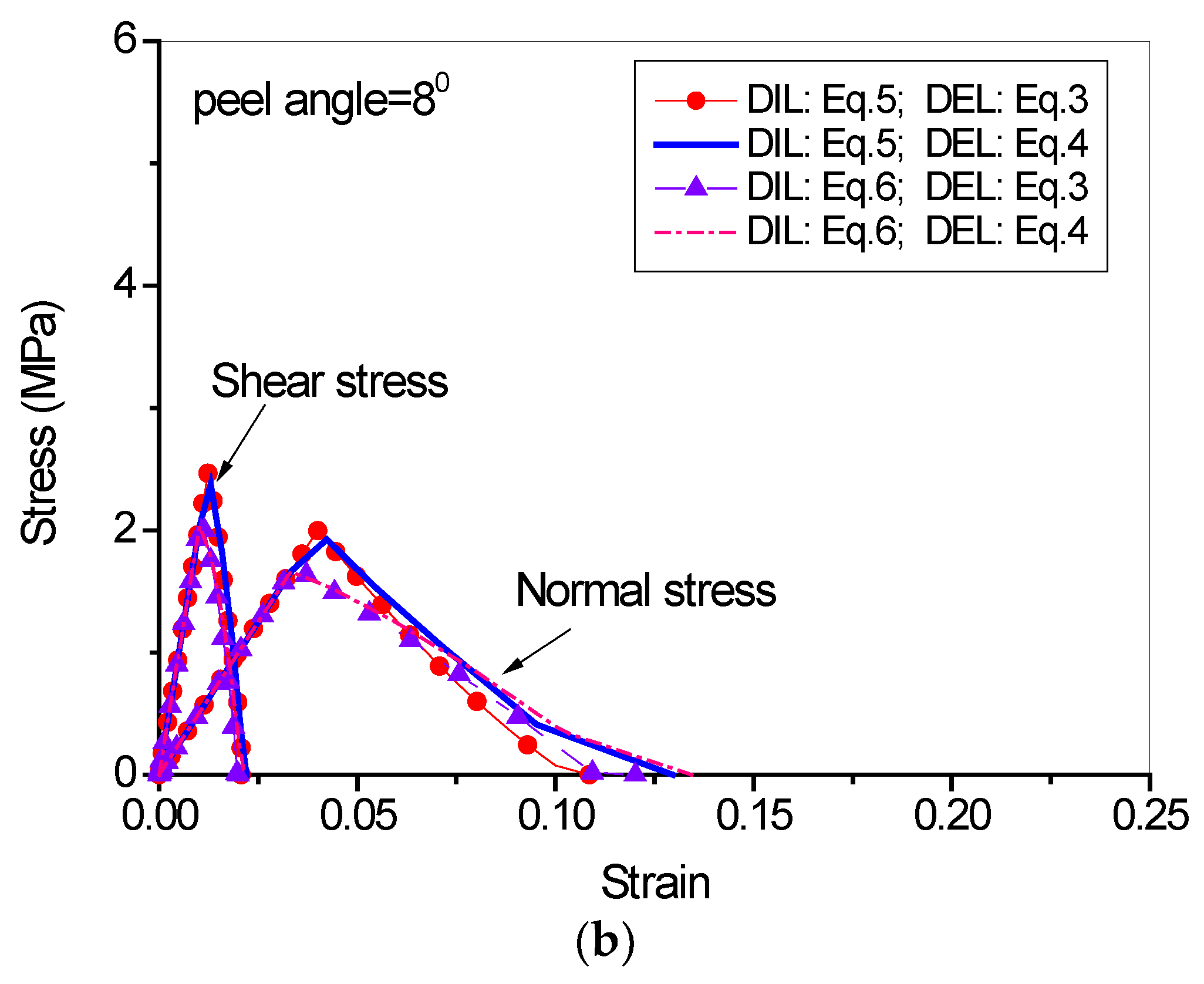


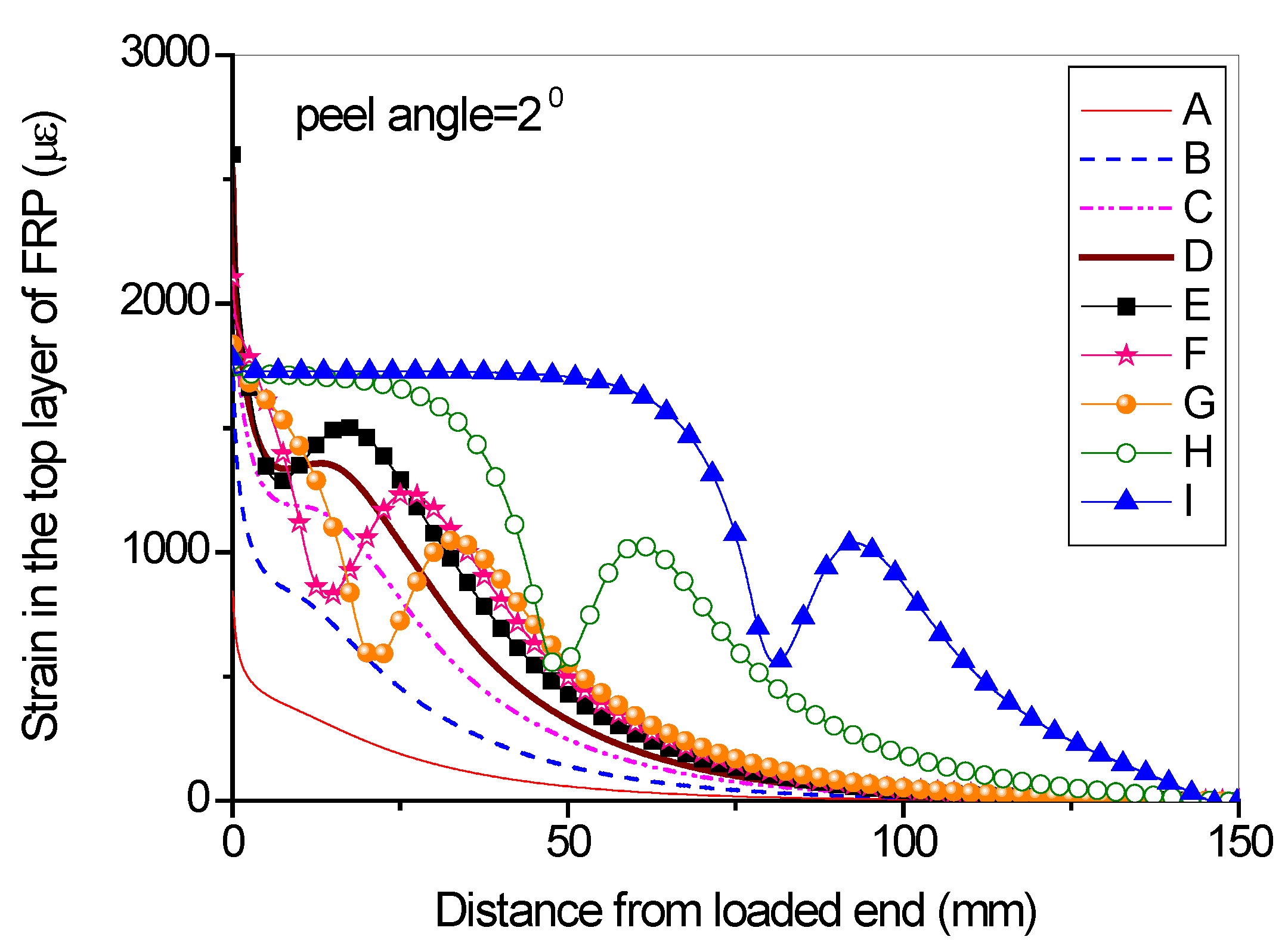
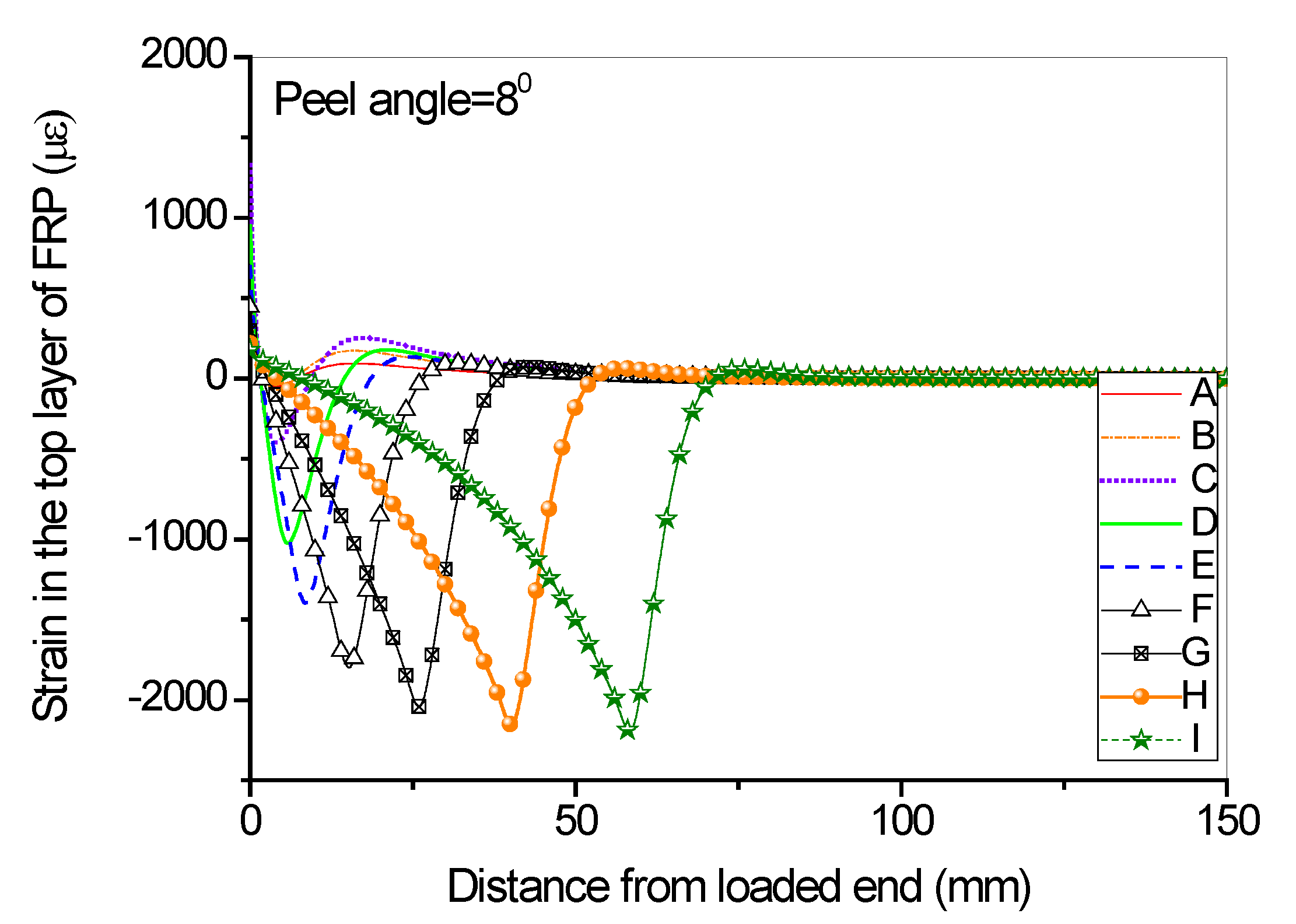
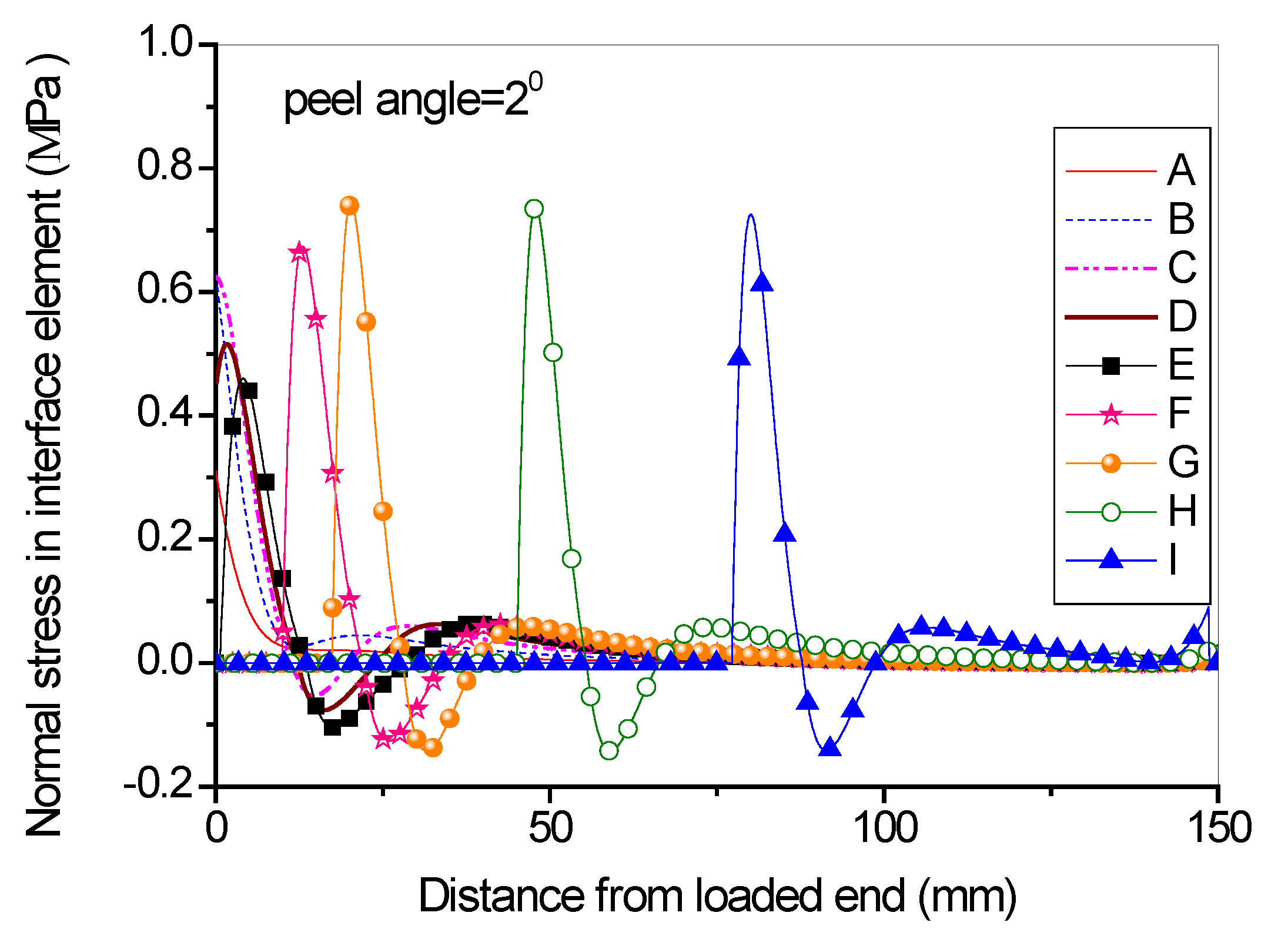
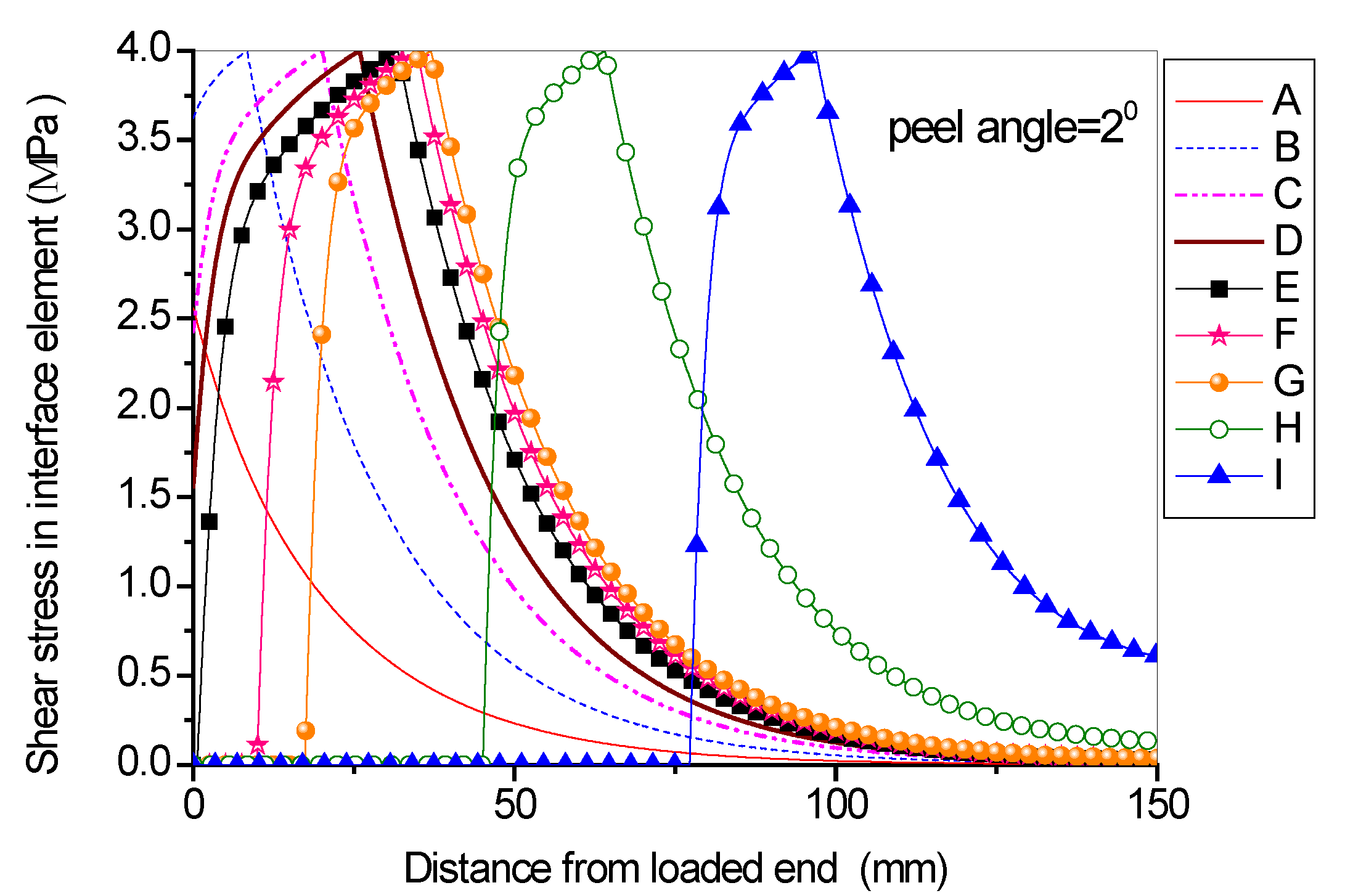
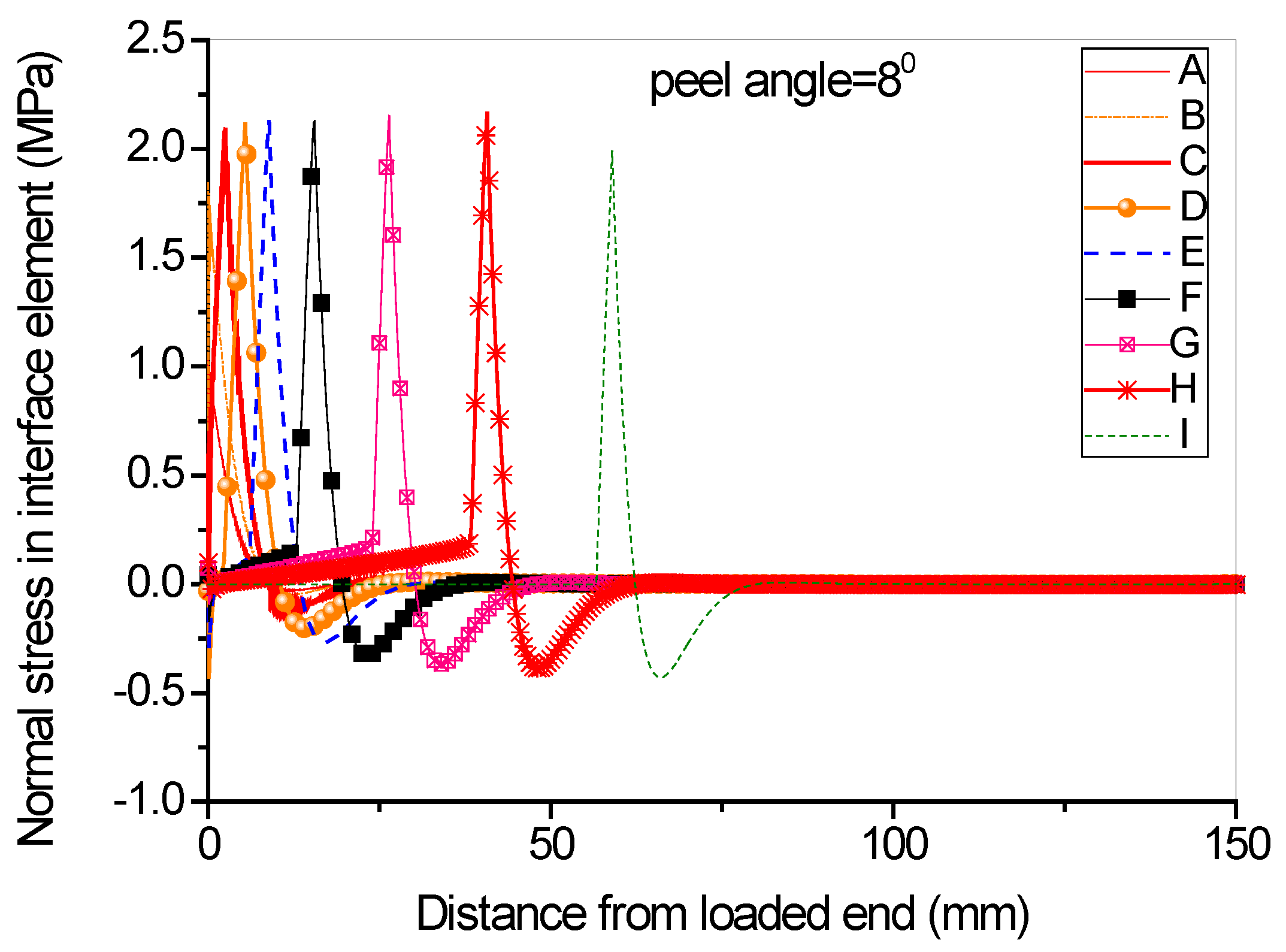
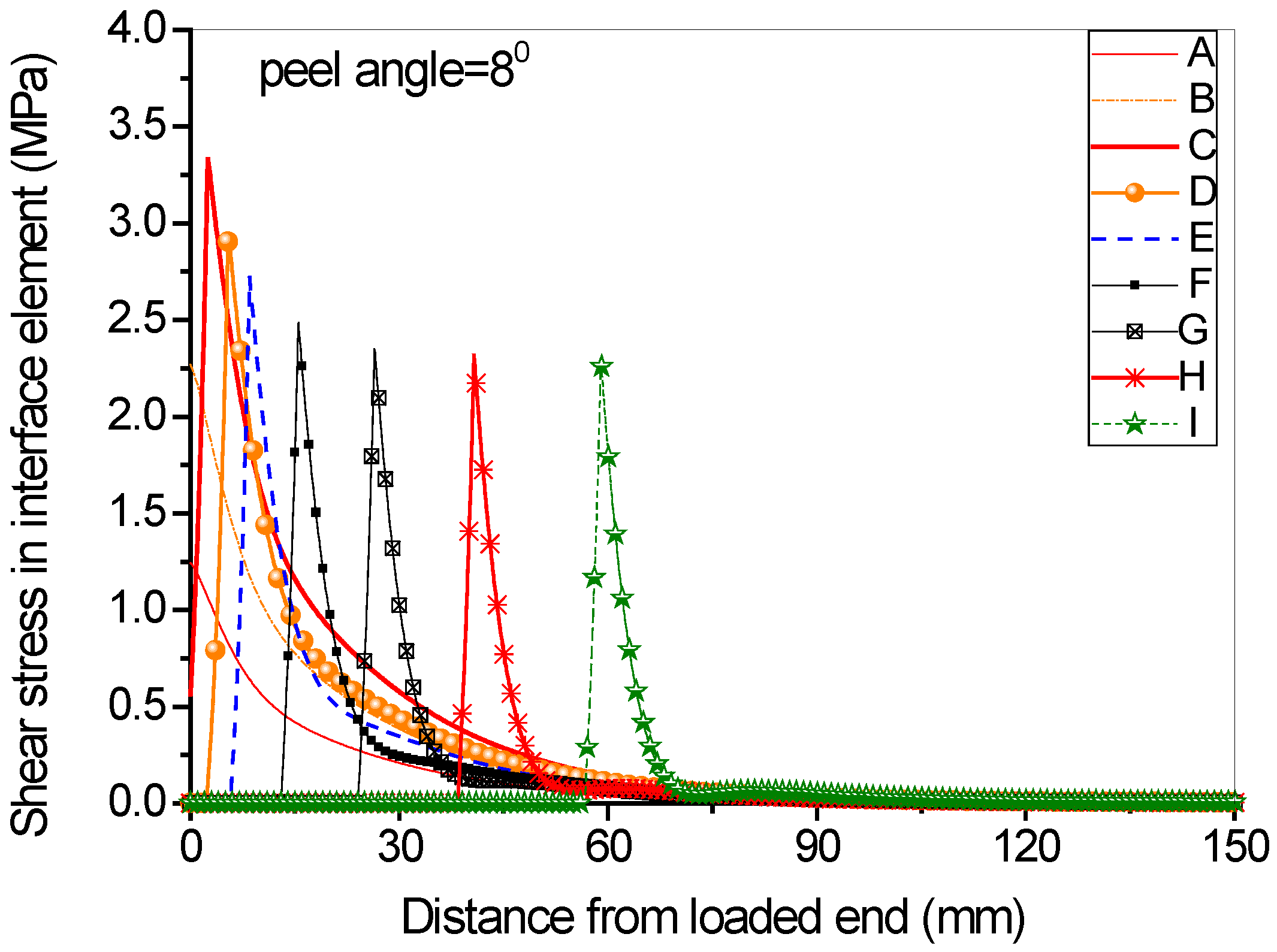
© 2017 by the authors. Licensee MDPI, Basel, Switzerland. This article is an open access article distributed under the terms and conditions of the Creative Commons Attribution (CC BY) license (http://creativecommons.org/licenses/by/4.0/).
Share and Cite
Yu, H.; Bai, Y.-L.; Dai, J.-G.; Gao, W.-Y. Finite Element Modeling for Debonding of FRP-to-Concrete Interfaces Subjected to Mixed-Mode Loading. Polymers 2017, 9, 438. https://doi.org/10.3390/polym9090438
Yu H, Bai Y-L, Dai J-G, Gao W-Y. Finite Element Modeling for Debonding of FRP-to-Concrete Interfaces Subjected to Mixed-Mode Loading. Polymers. 2017; 9(9):438. https://doi.org/10.3390/polym9090438
Chicago/Turabian StyleYu, Hui, Yu-Lei Bai, Jian-Guo Dai, and Wan-Yang Gao. 2017. "Finite Element Modeling for Debonding of FRP-to-Concrete Interfaces Subjected to Mixed-Mode Loading" Polymers 9, no. 9: 438. https://doi.org/10.3390/polym9090438




